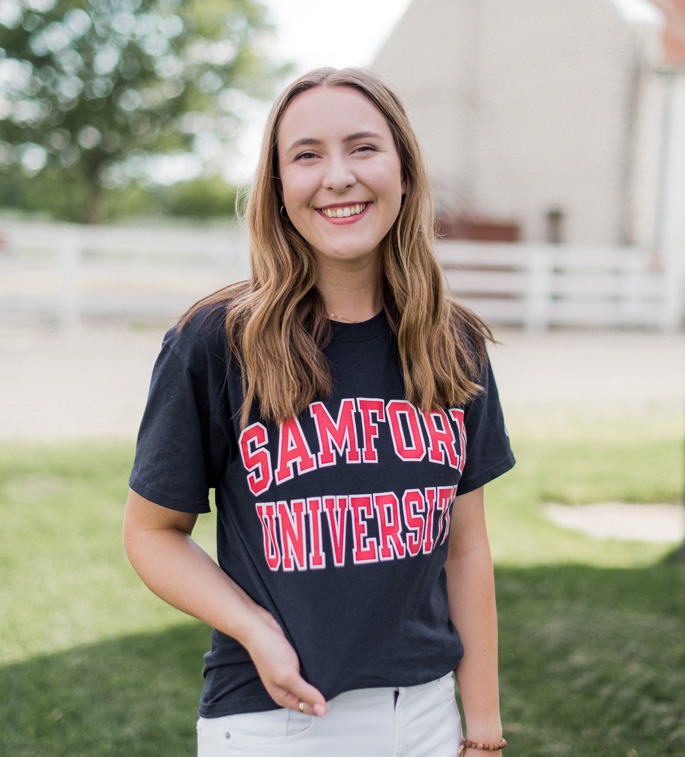by Jill Clendening
When Blair Wheeler banged her elbow on the court floor as she dived for a ball during a high school volleyball game, she had no idea that split second would completely change her life.

The dive caused the development of an odd tremor in her right hand and a tingling and weakness in her arm that brought an abrupt end to playing sports and forced the academically gifted Franklin High School freshman to require assistance in the classroom. For the next three years, she saw numerous specialists who couldn’t pin down a diagnosis. Meanwhile, Wheeler became a regular at physical and occupational therapy.
“Through multiple tests — MRIs of my spinal cord and brain, nerve conduction studies, EEGs to see if it might be seizure related — they just couldn’t determine why my hand was shaking,” Wheeler said. “Since no one could find a definitive answer, instead of continuing to try to address it medically, it turned into ‘How do we help you deal with this?’ And of course, I had to be right-handed.”
Wheeler’s now begun her freshman year at Samford University in Birmingham, Alabama, on a fast-track, six-year program to earn her doctorate of physical therapy degree.
Thanks to tenacious Vanderbilt University Medical Center doctors who suspected an unusual presentation of a not-so-unusual problem, her hand has stopped shaking and her arm is steadily getting stronger. She is still recovering from surgery, as nerve issues can often take months to resolve.
Heather Riordan, MD, assistant professor in the Division of Child Neurology, consulted Brinkley Sandvall, MD, assistant professor of Plastic Surgery and director of the Hand and Upper Extremity program at Monroe Carell Jr. Children’s Hospital at Vanderbilt, about her patient, and they were determined to not have Wheeler begin college with deficits.
Sandvall had a suspicion that the median nerve, the main nerve along the front of the forearm that fires muscles for the hand’s coarse movement, was involved despite nerve studies that didn’t prove that. She called on colleague Brad Hill, MD, assistant professor of Plastic Surgery, for another opinion.
“To be completely honest, Dr. Sandvall and I weren’t entirely convinced that this was what it was because we’ve never seen this manifestation — the involuntary movement — in the distribution of that nerve,” said Hill. “But there were symptoms we could provoke that were consistent with entrapment of the median nerve.”
When light pressure was applied to a muscle called the pronator teres, which is used to turn the palm up and down, Wheeler’s symptoms of weakness, numbness and tingling worsened, a sign of nerve entrapment. During her exam, Hill also spotted an issue with the ulnar nerve — the “funny bone” nerve that causes a sharp pain and tingling if the elbow is hit. Wheeler’s ulnar nerve slipped up and down or subluxated when she moved her arm.
Her medical team proposed fixing the ulnar nerve issue and during surgery investigating the median nerve.
She needed time to heal before college, and Hill could get her on his schedule the soonest, so he performed the procedure in late July.
“What I found was a lot of adhesion and inflammation around the median nerve at her elbow,” Hill said. “My guess is that the initial injury caused an inflammatory event that then led to the scarring and fibrosis that encased and entrapped the nerve.”
While Wheeler’s hand trembling was a completely unexpected symptom, median nerve entrapment at the elbow is actually not unusual, Hill said.
“This is sometimes called ‘carpal tunnel of the elbow’ because it’s entrapment or compression of the same nerve, just farther up the arm,” Hill said. “We see many patients with this who have been to multiple medical providers without a diagnosis. They have numbness and tingling, but nerve conduction tests indicate they don’t have carpal tunnel. Well, there are many areas where the median nerve can become entrapped.”
A patient’s physical activity can also provide clues, Hill said. Young, active females — and those who repetitively move their hand in a palm up, palm down motion — are the most common demographic to develop median nerve entrapment near the elbow. When he practiced in Baltimore where lacrosse is popular, Hill diagnosed several female players with this issue; he’s also diagnosed gardeners with the problem.
As for Wheeler, she credits her three-year journey to a diagnosis as a blessing, leading her to have more empathy for others with physical limitations. And her physical therapy team at Monroe Carell Jr. Children’s Hospital, who never stopped encouraging her, inspired her choice of physical therapy as future profession.
“When this first happened, I thought, ‘I really don’t need this,’ but honestly this has brought me so many opportunities,” she said. “It’s given me a different perspective, and I’m excited to become a physical therapist so I can help many other people.”












